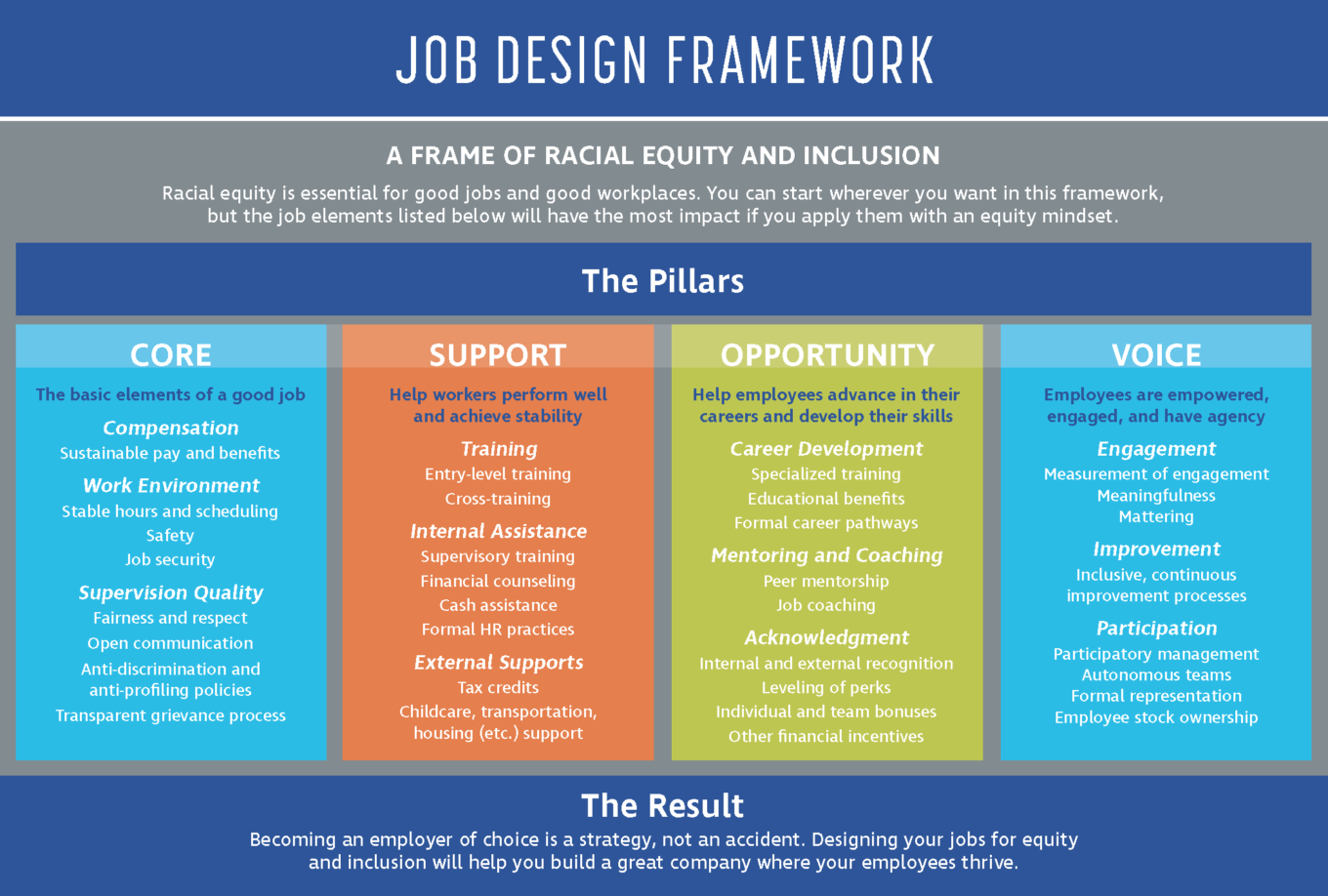Designing a Human-Centered Workplace
Intro to the Guide
We KNOW HIGHER QUALITY JOBS IMPROVE ORGANIZATIONAL OUTCOMES.
We also know that workers understand what a quality job looks like. This guide makes it easier for employers to center frontline workers in the job design process, and realize the full potential of their people and their performance.
Who Should Use the Guide
The guide is for executives, human resources specialists, operational leaders, and frontline leaders. The guide also has useful information for almost any organization that wants to center worker voices to enhance the quality of frontline jobs and improve outcomes.
Background. In 2019, the National Fund received funding from the Bill & Melinda Gates Foundation to work with small- and medium-sized businesses on implementing the National Fund’s Job Design Framework, which aims to make jobs better. Together with Design Impact (DI) and the Workforce & Organizational Research Center (WORC), we engaged five regional workforce collaboratives and eight employers to identify, develop, and test job quality interventions using an inclusive human-centered design process. We produced this guide based on what we learned during this year-long effort.
This collaboration reinforced what we’ve long believed: including frontline employees in job design is a key driver of success. Participants reported that approaching job design inclusively and collaboratively drove key organizational impacts in areas such as capacity building, leadership skill development, inclusiveness, belonging, and trust. For a deeper look at this process and how it impacted regional sites and employers, download the Project Impact Report.
Do you want to share feedback? Send us your guide feedback and human-centered design success stories to humanworkplace@nationalfund.org.
Decades of research confirms that better jobs result in better employer outcomes.
Focusing on making frontline jobs better is good for workers and good for business. For instance, it’s easier to retain workers in higher quality jobs. And new research from the National Fund and WORC tells us that improving job design can directly impact organizational performance, as measured by five key business outcomes.
Business Outcomes Impacting Organizational Performance
 |
Turnover Intention Whether an employee plans to leave their job |
 |
Commitment to the Organization How much an employee feels a sense of belonging and dedication to their organization |
 |
Individual Performance An employee’s self-assessment of the quality of their work on the job |
 |
Engagement at Work How much attention and energy an employee dedicates to their work |
 |
Burnout How much an employee becomes mentally, physically, and emotionally exhausted and drained by their work |
We believe that job design can help employers improve against these outcomes.
The National Fund, Design Impact, and WORC created this guide to help you design better jobs with workers at the center.
What is Job Design?
The National Fund is committed to promoting good jobs and investing in equitable outcomes. The phrase “job design” refers to the practice of making jobs better. As listed in the columns below, it looks at job qualities holistically, from foundational elements like pay and benefits, employee supports, and opportunities for growth.
Learn more in the Job Design Framework.

Why Center Workers in Job Design?
Given their day-to-day experiences with myriad problems and issues, frontline workers have critical insights into needed solutions. Yet these workers — mainly people of color and women — are often excluded from decision-making related to improving job design. We believe job design can be a tool to advance fairness and equity in organizational decision-making, amplifying historically excluded voices. If you want to improve jobs, center frontline workers in the process. The resulting changes are bound to be more effective, equitable, and sustainable.
What’s in the Guide?
This guide introduces a method for centering workers in job design. It will help you approach job design as a process undertaken with employees, not just for them.
The guide follows five steps, each with an interactive activity to help you apply the process at your organization.
- Planning for Job Outcomes
Focus job design efforts - Launching a Collaborative Workgroup
Approach job design creatively and inclusively - Learning from Employees
Center employee voices to understand key issues - Designing & Testing Solutions
Move ideas off “paper” into testable prototypes - Measuring the Impact on Business Outcomes
Measure the impact of your ideas against business outcomes
Planning Your Process
How long does this process take? We estimate anywhere from a few weeks to a few months. We recommend you spend a few hours thinking through Steps 1 and 2, which are deeply collaborative. When planning your timeline, be sure to account for schedules and capacities across roles.
You may also choose to jump into certain steps. For instance, you can start at Step 3: Learning from Employees or at Step 5 if you’re ready to measure and test what you’ve put into place.
At any point, download the Activity Workbook from the right navigation bar to review all activities at your own pace.


